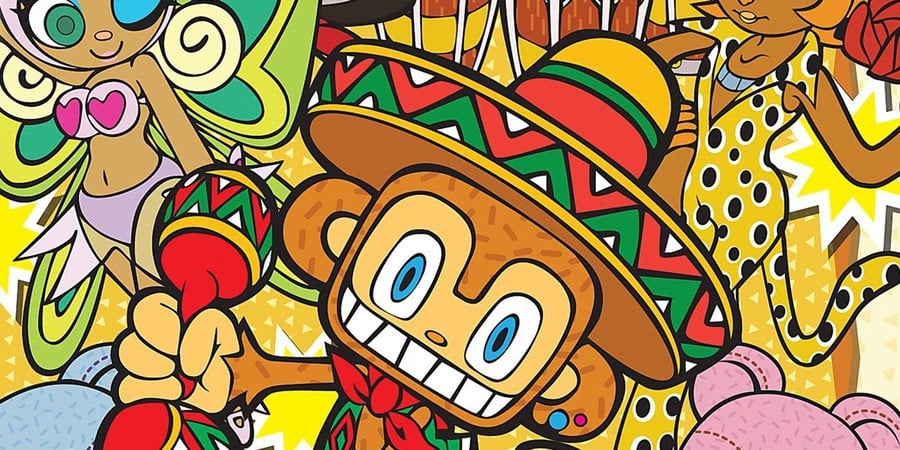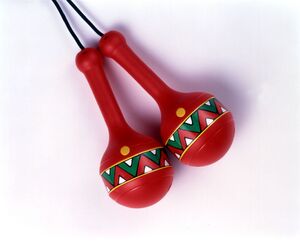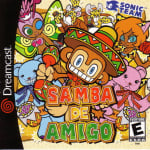
If you had to create a shortlist of the most colourful and creative Sega games, Samba de Amigo would no doubt rank toward the top.
Arriving in arcades back in 1999 (and on the Sega Dreamcast one year later in 2000), Sonic Team's Latin-inspired rhythm game about a sombrero-wearing monkey named Amigo was an instant hit with players, drawing a ton of praise at the time for its unique maraca-shaking gameplay, as well as its stylish art design and radio-friendly soundtrack. Because of this, it has since gone on to become regarded as something of a classic in Sega's back catalogue, and later ended up inspiring a Nintendo Wii port in 2008, as well as a multi-platform sequel, Samba de Amigo: Party Central, in 2023.
Something you might not know about Samba de Amigo, however, is that the game was, in reality, a product of a small and relatively inexperienced group of developers inside the company — one that had never created an arcade title in the past. As a result, the odds weren't always in its favour to become a success, with much of the team having yet to prove themselves at the company.
At Time Extension, recently, we had the special opportunity to put some questions about the game to one of these developers Satoshi Okano (who we previously interviewed about KaZe's SNES racer Uchuu Race: Astro Go! Go! earlier this year). He was a character artist who worked on the popular rhythm game and was responsible for the design of Amigo. He told us more about what it was like being part of the Samba de Amigo team and gave us some additional insight into the development of the game, from its initial concept up until its release. The following is a translation of our conversation with Okano, translated by the Japanese-to-English translator Stephen Meyerink, with some slight edits for clarity and length.
Time Extension: What was the original idea for the main character of Samba de Amigo?
Okano: Sonic Team, led by Yuji Naka-san, developed many original products. My first job with them after changing occupations was debug on Christmas NiGHTS. After that, I was a 3D CG map artist on Sonic Jam, Burning Rangers, and Sonic Adventure. During that time, I was also drawing official Sonic artwork. [Yuji] Uekawa-san was the main character designer for Sonic Team, and being good at designing characters, I stepped in there.
Around the end of Sonic Adventure's development, the team that was going to be continuing to work on Sonic transferred to San Francisco. This was dozens of people, headed up by Takashi Iizuka-san. That's the team that then created Sonic Adventure 2. The Sonic Team people who remained in Japan were assigned to projects as determined by Yuji Naka-san and the bosses.
However, those projects had a lot of troubles. Amidst all that, Shun Nakamura-san (the current head of Sonic Team) showed a plan printed on a single sheet of A4 to Yuji Naka-san. Naka-san said, "Give it a try." Still, we couldn't assign many staff members to it.
Three new employees ended up making a prototype. The prototype was a screen of a monkey dancing and holding maracas on a monitor. They made use of a circuit board codenamed Naomi (which had compatibility with both Dreamcast and arcade hardware).
Shun Nakamura-san made a presentation to Yuji Naka-san in which a new guy at the company danced with maracas in front of that moving screen. Of course, they hadn't created a movement system at all, because at this point it was nothing more than fictional technology. Yuki Naka-san roared with laughter. After that, the other struggling projects were shut down, and they were given the go-ahead to continue development.

Time Extension: How did you initially become involved with the project?
Okano: Naka-san asked Sonic Team, "Does anyone want to participate in this project?" My gut reaction was that this project could really sell, so I replied, "I've only ever been a map artist, but I'd like to be the character designer!" and raised my hand. Maybe one or two other people raised their hands too, but I recall it not being all that popular. The team ended up having three programmers, three [art] designers, and Shun Nakamura and one other person handling design. It was a really small team, almost like one they would've had on an NES title.
Uekawa-san made a 3D model with relatively few polygons and no texture mapping. While we were all taking a look at it, I shared my opinion: "Hey, a monkey with a square face could be pretty fun, huh?"
Yuji Naka-san told [the Sonic Team character designer] Yuji Uekawa not to do any development work and just to check in on the game's art once a month. From that point, we started discussing what to actually do with the monkey character. I drew up a few designs, but we couldn't make a decision. Yuji Naka-san just didn't like any of them. And so then, Uekawa-san made a 3D model with relatively few polygons and no texture mapping. While we were all taking a look at it, I shared my opinion: "Hey, a monkey with a square face could be pretty fun, huh?" and then everyone was really into it. Uekawa brought together the designs I had done and designed Amigo.
Time Extension: Could you talk a little bit more about Uekawa-san's involvement in Samba de Amigo? He was credited as an art director, we believe. Can you remember any of his suggestions for the character of Amigo or what his response was to your art?
Okano: Uekawa-san didn't express much in the way of likes or dislikes. The OKs and NGs ("no goods") were all given by Yuji Naka-san.
Uekawa-san would do a design, and then I'd start to make the character in 3D. Uekawa-san wanted photorealistic textures, but I said, "I'll do some UN-photorealistic textures" that could be designed in Adobe Illustrator. Even so, Uekawa-san didn't yield, and he asked me to at least just give Amigo's straw hat a textured look. I wanted to make things in a fun way because I had to keep the team spirit up. My answer to him was, of course, "OK!"
Time Extension: Could you talk about the rest of the characters in the game and how they came to life? How easy were they to develop once you had designed Amigo?
Okano: After that point, the team's development got more and more wildly enthusiastic. It was an extremely fun two years. I handled the character designs, and Uekawa-san gave his opinions. Finally, together with Yuji Naka-san and Shun Nakamura-san, the four of us would make a final decision.
I proposed designs for Linda, a girl with brown skin and big eyes wearing a butterfly outfit, and Bingo Bongo, a pair of bears with even smaller bears inside of them. Someone pointed out that their legs had no joints, but I stuck to my guns.
The proposals were given the OK one after another—it went very smoothly. I made Chumba and Wamba as senior musicians. I almost always got the OK on my first go-around. One time, speaking about Rio, Yuji Naka said, "Do you think people will assume I'm interested in genderless characters like this, given the fact that I'm not married?" I replied jokingly, "That'd be funny!"
In Japan, there was a follow-up to the game called Samba de Amigo Ver. 2000 that never got an overseas release. That game had a new character in it called Amiga, and she was really tough to get designed, because men all want to give their opinions on female characters. I submitted around 30 or 40 designs, and after all of that, the most orthodox idea of them all was the one that was accepted.
Unphotorealistic designs and rough illustrations were a feature of Samba de Amigo['s development]. The 2D illustrations were drawn by Uekawa-san and myself. We followed the same process as that of Sonic Adventure, in which I would do rough designs that he would trace. In terms of what we each drew, he did the package illustration, and I did the illustrations on the game screens, as well as the ones in the strategy guide.
Time Extension: Do you have any other memories of the game's development you can share? What it was like working with such a small team?
Okano: Since the team was so small, all of us ended up sharing opinions that went beyond our specific roles on the project.
At the start, the left side of the game screen showed the UI for both players, and the right side had the characters dancing. I felt it was hard to play like that, and I went and told Shun Nakamura. I felt it would be better if each person's UI was on each side of the screen, with the performing characters behind that. Sonic Team was still in the midst of working on difficult project[s], so the senior planner there next to Shun Nakamura glared at me. Conversely, planner Tomohiko Aita pointed out, “It's weird that Rio dances with his mouth open.” I pointed out that Rio dancers dance with their mouths open. But it was no battle. I've spoken about some of my memories [on Game Developer] in the past. But there are more memories I haven't talked about yet.
Time Extension: We'd love to hear them if you can share...
Okano: During the development of Samba de Amigo, our executive vice president came to Sonic Team's offices to play the game at Yuji Naka-san's invitation. This was because our game was a rare chance for the consumer department team to venture into the arcade industry.
Vice President [Hisashi] Suzuki had gotten his start in the arcade industry, and he took a liking to Samba de Amigo. But then [the current Sega Corporation president] Shuji Utsumi, showed up and was like, "Never mind that, Suzuki-san. You want to go get some lunch?" and took the VP away with him. I wonder what Yuji Naka thought of that. Utsumi-san will have been president for a year this April. He's an advocate for smartphones. I'm expecting a bit of a revival in terms of console games. I want him to do his best—I think we're really going to see what he's made of from here on.
Time Extension: Do you have any insight into how the iconic controller concept was realized?
Okano: [The maracas] were the product of the hard work of [SEGA's] arcade machine developers. In those days, spatial recognition sensors in games were still deep in development. And yet those developers made Shun Nakamura's fanciful idea into a reality. We went back and forth across the street to the arcade machine team[s]'s offices to ask them questions. In the end, the device [they came up with] was wired, but it made the fun of shaking the maracas to play into a reality.
Kenji Tosaki-san and the whole team were wonderful. The peripherals for the Dreamcast version and the arcade game's hardware were different systems. It's a truly amazing thing. "Creativity is life" is SEGA's company policy, and those guys really gave us a first-hand demonstration of that.

We were interviewed by a number of gaming magazines. The former HAL Laboratory and then Nintendo president Satoru Iwata-san read those interviews in Kyoto. He and I used to exchange New Year's greeting cards. In 2000 or 2001, he wrote in his card, "You know, Shigeru Miyamoto also likes Samba de Amigo.
Yuji Naka-san also kept up personal correspondence with Iwata-san, as well. This was around the time when SEGA gave up on the Dreamcast and was going to start releasing [games] on Nintendo's consoles.
I read that Yuji Naka-san said something to the following effect in the media of some kind: "Nintendo Wii may have been inspired by Samba de Amigo." Yuji Naka-san and Satoru Iwata-san keeping in touch, as well as the New Year's greeting Iwata-san sent to me [that year], might serve as some evidence of that.
Finally, how did it feel to see your characters given new life in Samba de Amigo: Party Central?
Okano: I think Samba de Amigo: Party Central is really well made. We downloaded the demo at home and my family had fun playing it. My son was 5 years old at the time and it was a little difficult for him, so we weren't sure whether or not we were going to buy it. But it did make me understand that SEGA really values its old intellectual property.
Right now in the game industry, development costs for a title exceed 13 million dollars. That being the case, it's pretty difficult for companies to take big risks on new products. That's why it makes for a good policy to rework an old hit IP in a modern way. That does make sense to me.
Still, I want SEGA and Sonic Team to keep on doing their best and not to forget that sense of being on the cutting edge, of going one step ahead of the rest of the world. Samba de Amigo isn't cool like Dance Dance Revolution. It's funny, in a good way. And I felt that sense of identity from Samba de Amigo: Party Central. I hope it can weather the rough seas of the times.


